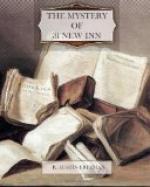CHAPTER.
I the mysterious patient
II Thorndyke devises A scheme
III “A Chiel’s Amang Ye takin’
notes”
IV the official view
V Jeffrey Blackmore’s will
VI Jeffrey Blackmore, deceased
VII the cuneiform inscription
VIII the track chart
IX the house of mystery
X the Hunter hunted
XI the Blackmore case reviewed
XII the portrait
XIII the statement of Samuel Wilkins
XIV Thorndyke lays the mine
XV Thorndyke explodes the mine
XVI an exposition and A tragedy
Chapter I
The Mysterious Patient
As I look back through the years of my association with John Thorndyke, I am able to recall a wealth of adventures and strange experiences such as falls to the lot of very few men who pass their lives within hearing of Big Ben. Many of these experiences I have already placed on record; but it now occurs to me that I have hitherto left unrecorded one that is, perhaps, the most astonishing and incredible of the whole series; an adventure, too, that has for me the added interest that it inaugurated my permanent association with my learned and talented friend, and marked the close of a rather unhappy and unprosperous period of my life.
Memory, retracing the journey through the passing years to the starting-point of those strange events, lands me in a shabby little ground-floor room in a house near the Walworth end of Lower Kennington Lane. A couple of framed diplomas on the wall, a card of Snellen’s test-types and a stethoscope lying on the writing-table, proclaim it a doctor’s consulting-room; and my own position in the round-backed chair at the said table, proclaims me the practitioner in charge.
It was nearly nine o’clock. The noisy little clock on the mantelpiece announced the fact, and, by its frantic ticking, seemed as anxious as I to get the consultation hours over. I glanced wistfully at my mud-splashed boots and wondered if I might yet venture to assume the slippers that peeped coyly from under the shabby sofa. I even allowed my thoughts to wander to the pipe that reposed in my coat pocket. Another minute and I could turn down the surgery gas and shut the outer door. The fussy little clock gave a sort of preliminary cough or hiccup, as if it should say: “Ahem! ladies and gentlemen, I am about to strike.” And at that moment, the bottle-boy opened the door and, thrusting in his head, uttered the one word: “Gentleman.”
Extreme economy of words is apt to result in ambiguity. But I understood. In Kennington Lane, the race of mere men and women appeared to be extinct. They were all gentlemen—unless they were ladies or children—even as the Liberian army was said to consist entirely of generals. Sweeps, labourers, milkmen, costermongers—all were impartially invested by the democratic bottle-boy with the rank and title of armigeri. The present nobleman appeared to favour the aristocratic recreation of driving a cab or job-master’s carriage, and, as he entered the room, he touched his hat, closed the door somewhat carefully, and then, without remark, handed me a note which bore the superscription “Dr. Stillbury.”




